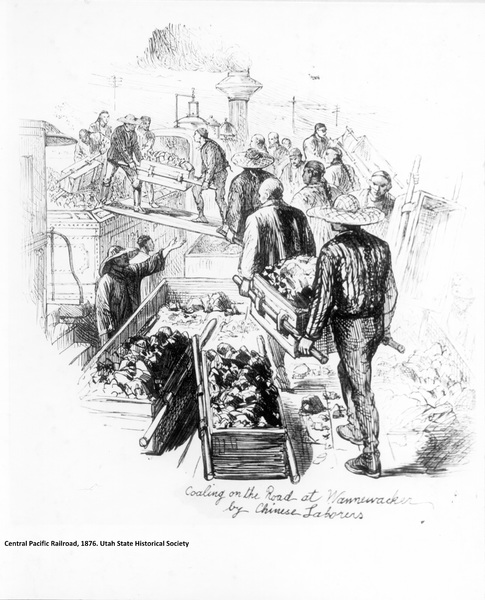Dublin Core
Title
Description
Chinese immigrant laborers built the railroad from California to Utah.
On May 10, 1869 the Union Pacific and Central Pacific Railroads joined at Utah’s Promontory Point, completing the first transcontinental railroad system in the United States. Without the efforts of over 12,000 Chinese immigrant laborers, it is highly doubtful that the Central Pacific Railroad would have been successful in laying its part of the track between California and northern Utah.
Most of the Chinese workers on the railroad came from southern China’s Guangdong Province, a region wracked in the 1800s by natural disasters, social upheaval, and economic scarcity. In the face of these problems, many Chinese looked to emigration is a way to improve their circumstances, and the discovery of gold in California seemed to highlight the boundless opportunities in America. Traveling through Hong Kong to San Francisco – a journey that averaged two months – Chinese immigrants flooded into the American West. The first wave came as indentured servants, while those who came later were advanced the $40 passage by Hong Kong brokerage firms that collected the voyage debt from a worker’s eventual earnings.
At first, the managers of the Central Pacific Railroad were wary of Chinese workers, but after hiring an initial 50 men and realizing how industrious and precise they were, the company opened the door to more workers from China. Blasting and chipping their way over the Sierra Nevada, the Chinese laborers eventually cleared mountains and sped toward Promontory where the famous Golden Spike was finally driven.
Those first railroad workers spawned a variety of Chinese neighborhoods in communities across Utah, especially in cities and towns where mining and the railroad were important parts of the economy. Corinne had a thriving Chinese community, as did Ogden, Salt Lake, Park City, and the mining towns of Carbon County.
Racial prejudice and restrictive immigration laws – such as the Chinese Exclusion Act of 1882 – specifically targeted Chinese people and took a toll on these communities. Nonetheless, people of Chinese ancestry remain an important part of Utah’s social and cultural landscape.
Creator
Megan van Frank and Brandon Johnson for Utah Humanities © 2014
Source
Image: Central Pacific Railroad. Illustration of coaling on the road at Wannewacker by Chinese laborers. 1876. Courtesy of Utah State Historical Society.
_______________
See Don Conley, “The Pioneer Chinese of Utah,” in The Peoples of Utah, ed. Helen Z, Papanikolas (Salt Lake City: Utah State Historical Society, 1981), pp 251-277; Don Conley, “The Chinese in Utah,” online Utah History Encyclopedia; David Howard Bain, Empire Express: Building the First Transcontinental Railroad (New York: Penguin, 1999); Nancy J. Taniguchi, Castle Valley, America: Hard Land, Hard-Won Home (Logan: Utah State University Press, 2004), pp 58-59; see the text of the 1882 Chinese Exclusion Act and learn more about Chinese immigration to the United States at the National Archives website.
Publisher
The Beehive Archive is a production of Utah Humanities. Find sources and the whole collection of past episodes at www.utahhumanities.org
Date
2014-12-12

